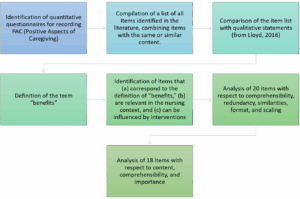Here, you can find all the information on the construction and validation of the Benefits of Being a Caregiver Scale (BBCS). If you have any further questions or suggestions, please do not hesitate to contact us.
Item Construction
The Benefits of Being a Caregiver Scale (BBCS) was developed in seven steps: The process included literature reviews, content analyses, surveys, and focus groups. In addition, experts from various disciplines, nursing consultants, and family caregivers were involved in the development process (see flow chart below).

The BBCS was validated using data from 961 caregivers (CGs) who were 61 years old on average and mostly women (76.2%). The average age of the care recipients was 77 years, with 64% women. Further information on the characteristics of the sample can be found in Table 3 of the validation study by Pendergrass and colleagues (2023).
Item difficulty, discriminant validity, and Cronbach’s alpha were calculated. An exploratory factor analysis was conducted to determine the structure of the BBCS. Convergent and divergent validity were determined by testing four hypotheses.
Convergent validity was tested with H1-H3, and divergent validity was tested with H4 (the hypotheses were derived from findings in the scientific literature):
- H1: Because the “Positive Aspects of Caregiving” (PAC, Tarlow et al., 2004) and the BBCS measure similar constructs, the two scales were expected to be strongly positive correlated.
- H2a: CG´s adaptive coping (emotion-focused, problem-focused; measured by using COPE 6, based on the Brief COPE by Carver, 1997) was expected to be rather positively correlated with the BBCS sum score.
- H2b: CG´s maladaptive coping (dysfunctional; measured by using COPE 6, based on the Brief COPE by Carver, 1997) was expected to be not correlated with the BBCS sum score.
- H3: A positive current relationship quality was expected to be positively correlated with the BBCS.
- H4: No correlation was expected between the BSFC-s (Burden Scale for Family Caregivers – short form; Graessel et al., 2014) and the BBCS.
The results are summarized in Table 3 in Pendergrass et al. (2023).
The difficulty of the BBCS items ranged from .28 to .67. The discriminatory power of the items ranged from .45 to .74. The item “Through caring for my … I have met other caregivers who are important to me” showed the lowest discriminatory power (moderate size). For 14 items, Cronbach’s alpha “if item deleted” was below the Cronbach’s alpha value of .922 calculated for the entire scale. Because the Cronbach’s alpha value for the item “Through caring for my… I have met other caregivers who are important to me” was .922, this item was removed from the scale and further analysis. The results are summarized in Table 2 by Pendergrass and colleagues (2023).
Exploratory factor analysis revealed a one-factor structure of the BBCS. Only one component had an eigenvalue greater than 1.0 (eigenvalue = 6.9). This factor explained 49.8% of the total variance of the BBCS sum score. All 14 items had high loadings (> .50) on this factor.
The scree plot shows the distribution of the eigenvalues of the components:

Carver, C. S. (1997). You want to measure coping but your protocol’too long: Consider the brief cope. International Journal of Behavioral Medicine, 4(1), 92-100.
Graessel, E., Berth, H., Lichte, T., & Grau, H. (2014). Subjective caregiver burden: validity of the 10-item short version of the Burden Scale for Family Caregivers BSFC-s. BMC Geriatrics, 14, 1-9.
Pendergrass, A., Weiß, S., Rohleder, N., & Graessel, E. (2023). Validation of the Benefits of Being a Caregiver Scale (BBCS)–further development of an independent characteristic of informal caregiving. BMC Geriatrics, 23(1), 26.
Tarlow, B. J., Wisniewski, S. R., Belle, S. H., Rubert, M., Ory, M. G., & Gallagher-Thompson, D. (2004). Positive aspects of caregiving: Contributions of the REACH project to the development of new measures for Alzheimer’s caregiving. Research on Aging, 26(4), 429-453.
Benefits of Being a Caregiver Scale (BBCS); Caregivers (CGs)
